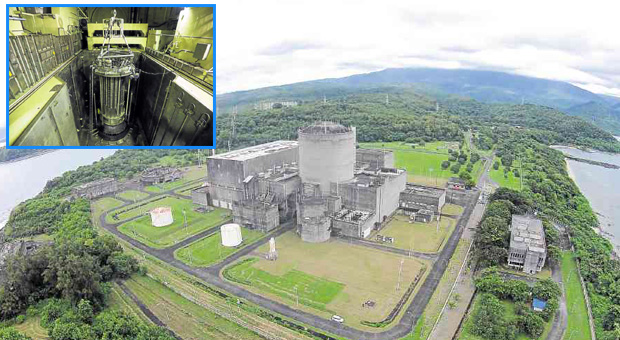Senators split on using idle nuclear plant

STILL CONTROVERSIAL AFTER ALL THESE YEARS The mothballed Bataan Nuclear Power Plant (shown in this drone shot) in Morong, Bataan, has yet to produce a single watt of energy. Inset photo shows the containment building of the plant, which contains the reactor. REM ZAMORA and LYN RILLON
Cost or safety?
The debate on the use of nuclear energy to answer the country’s increasing demand for power has boiled down to concerns about the safety of the mothballed Bataan Nuclear Power Plant (BNPP) against its cost-effective energy supply.
On a visit at the Morong, Bataan site of the BNPP on Friday, Sen. Sherwin Gatchalian expressed reservations about using the 620-megawatt power plant completed during the term of deposed President Ferdinand Marcos because of “safety and structural concerns,” while Senators Nancy Binay and JV Ejercito said they were open to exploring nuclear power as the country looked for reliable and cheaper sources of energy.
Gatchalian, who chairs the Senate committee on energy, cautioned against using the BNPP, which he described as “old” and “full of controversies.”
“If we want to go into nuclear power, let’s do it right from the beginning, meaning let’s use the latest technology,” the senator said, adding that the BNPP was built 40 years ago, “so [the structure] is old.”
“We have to make sure that everyone is consulted—the communities, province, even religious groups, so that everyone is heard and their fears addressed,” he added.
“We can study nuclear power but not the revival of the BNPP,” Gatchalian said.
‘Exaggerated fears’
Ejercito said the nuclear plant could bring down power cost that, in turn, could revive the manufacturing industry. The condition of the BNPP “was still good,” and “it could still be revived,” the senator added.
Former Pangasinan Rep. Mark Cojuangco, who joined the senators during the visit to the plant, also supported reviving the BNPP and said “exaggerated fears” were preventing the country from using the nuclear power plant.
“The BNPP is safe. A nuclear power plant emits nothing. It means less carbon dioxide and pollution everywhere,” said Cojuangco, who was a resource speaker during a technical briefing for journalists in Bagac town.
“There’s a 50-year history (in the) nuclear power industry that can attest to the fact that a nuclear power plant is safe,” he added.
According to Mauro Marcelo, manager of the National Power Corp. asset preservation department, an estimated $1 billion would be needed to rehabilitate the BNPP while constructing a new nuclear power plant would cost around $6 billion.
Safety concerns
The BNPP was completed in 1984 and had been set for commercial operations in June 1985 but it was mothballed by President Corazon Aquino in 1986 due to safety concerns.
The nuclear plant cost the government some $2 billion, with Filipino taxpayers carrying the burden of paying $300,000 in daily interests for the loans borrowed by the Marcos administration.
Reopening the BNPP would require a $1-billion investment, according to Energy Secretary Alfonso Cusi who did not attend the inspection, an amount that Gatchalian said the government could spend for “more feasible energy-generation projects.”
“This is just the first step. Next hearing, maybe we can invite those who oppose [nuclear power],” said committee vice chair Binay, who said she was in favor of operating the BNPP if it passed standards and proves itself to be cost-effective. With a report from Ana Roa, Inquirer Research/TVJ
RELATED STORIES
Nuclear power ‘a good option’ for PH—Cusi
PH gov’t considers nuclear energy as int’l conference kicks off